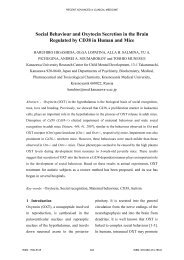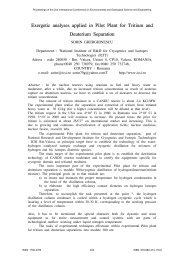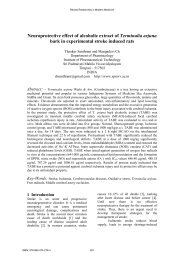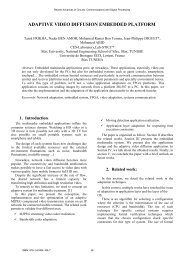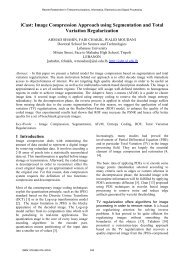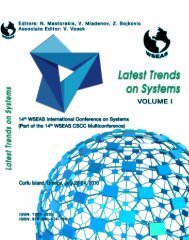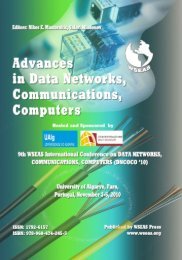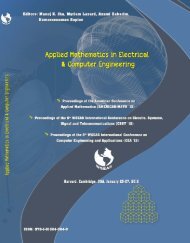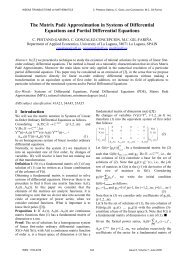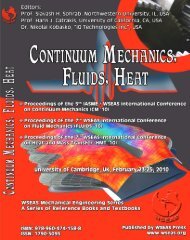The SQUID as Diagnostic Tool in Medicine and its Use ... - Wseas.us
The SQUID as Diagnostic Tool in Medicine and its Use ... - Wseas.us
The SQUID as Diagnostic Tool in Medicine and its Use ... - Wseas.us
Create successful ePaper yourself
Turn your PDF publications into a flip-book with our unique Google optimized e-Paper software.
<strong>The</strong> <strong>SQUID</strong> <strong>as</strong> <strong>Diagnostic</strong> <strong>Tool</strong> <strong>in</strong> Medic<strong>in</strong>e <strong>and</strong> <strong>its</strong> <strong>us</strong>e<br />
with other Experimental Stimulation <strong>and</strong> <strong>The</strong>oretical<br />
Methods for Evaluation <strong>and</strong> Treatment of Vario<strong>us</strong><br />
Dise<strong>as</strong>es<br />
Photios A. Ann<strong>in</strong>os<br />
Emerit<strong>us</strong> Professor<br />
Democrit<strong>us</strong> University of Thrace<br />
Alex<strong>and</strong>roupolis, Greece<br />
Published by WSEAS Press<br />
www.wse<strong>as</strong>.org<br />
ISBN: 978-960-474-289-9
<strong>The</strong> <strong>SQUID</strong> <strong>as</strong> <strong>Diagnostic</strong> <strong>Tool</strong> <strong>in</strong> Medic<strong>in</strong>e <strong>and</strong> <strong>its</strong> <strong>us</strong>e<br />
with other Experimental Stimulation <strong>and</strong> <strong>The</strong>oretical<br />
Methods for Evaluation <strong>and</strong> Treatment of Vario<strong>us</strong><br />
Dise<strong>as</strong>es<br />
Published by WSEAS Press<br />
www.wse<strong>as</strong>.org<br />
Copyright © 2011, by WSEAS Press<br />
All the copyright of the present book belongs to the World Scientific <strong>and</strong> Eng<strong>in</strong>eer<strong>in</strong>g Academy <strong>and</strong><br />
Society Press. All rights reserved. No part of this publication may be reproduced, stored <strong>in</strong> a retrieval<br />
system, or transmitted <strong>in</strong> any form or by any means, electronic, mechanical, photocopy<strong>in</strong>g, record<strong>in</strong>g, or<br />
otherwise, without the prior written permission of the Editor of World Scientific <strong>and</strong> Eng<strong>in</strong>eer<strong>in</strong>g Academy<br />
<strong>and</strong> Society Press.<br />
All papers of the present volume were peer reviewed by two <strong>in</strong>dependent reviewers. Acceptance w<strong>as</strong><br />
granted when both reviewers' recommendations were positive.<br />
See also: http://www.worldses.org/review/<strong>in</strong>dex.html<br />
ISBN: 978-960-474-289-9<br />
World Scientific <strong>and</strong> Eng<strong>in</strong>eer<strong>in</strong>g Academy <strong>and</strong> Society
Preface<br />
In this book we are go<strong>in</strong>g to deal with an important subject namely, the magnetic fields emitted from human<br />
subjects for the purpose to underst<strong>and</strong> <strong>and</strong> evaluate normal <strong>and</strong> abnormal functions <strong>and</strong> furthermore for the<br />
treatment of CNS disorders. <strong>The</strong> ionic currents which are orig<strong>in</strong>ated from biochemical sources at the<br />
cellular level <strong>in</strong> the central nervo<strong>us</strong> system (CNS) produce not only electric fields, but also magnetic fields.<br />
<strong>The</strong>se fields can be me<strong>as</strong>ured <strong>in</strong> the bra<strong>in</strong> <strong>and</strong> surround<strong>in</strong>g tissues by very sensitive <strong>and</strong> sophisticated<br />
magnetic field detectors which are called <strong>SQUID</strong>’s. <strong>The</strong> behavior of these fields can be predicted beca<strong>us</strong>e<br />
they obey physical laws. <strong>The</strong> generation of the electroencephalogram (EEG) signals <strong>in</strong> the bra<strong>in</strong>, <strong>in</strong><br />
biophysical terms, is the exact way to determ<strong>in</strong>e the potential distribution at the scalp given a set of<br />
<strong>in</strong>tracerebral current sources. In general terms, the field potential of a population of neurons equals the sum<br />
of the field potentials of the <strong>in</strong>dividual neurons. In order to underst<strong>and</strong> the EEG phenomena, the activity of<br />
a population of neurons m<strong>us</strong>t always be considered. EEG phenomena can only be me<strong>as</strong>ured at a<br />
considerable distance from the source if the responsible neurons are regularly arranged <strong>and</strong> activated <strong>in</strong> a<br />
more or less synchrono<strong>us</strong> way. Th<strong>us</strong>, while with the EEG it is very difficult to localize where a particular<br />
signal orig<strong>in</strong>ates <strong>in</strong> the bra<strong>in</strong>, <strong>in</strong> the c<strong>as</strong>e of the magnetic field <strong>and</strong> with the <strong>us</strong>e of the<br />
(magnetoencephalogram) MEG it is e<strong>as</strong>ier to localize where the signals orig<strong>in</strong>ate from the bra<strong>in</strong>. <strong>The</strong> MEG<br />
is presently regarded <strong>as</strong> the most efficient method for record<strong>in</strong>g the bra<strong>in</strong> activity <strong>in</strong> real time for many<br />
re<strong>as</strong>ons. Compared with the EEG, the MEG h<strong>as</strong> unique sensitivity to the CNS disorders <strong>and</strong> normal<br />
functions of the bra<strong>in</strong>. In addition, the MEG offers functional mapp<strong>in</strong>g <strong>in</strong>formation <strong>and</strong> me<strong>as</strong>urement of<br />
bra<strong>in</strong> activity <strong>in</strong> real time, unlike CT, MRI <strong>and</strong> fMRI which only provide structural, anatomical <strong>and</strong><br />
metabolic <strong>in</strong>formation. With the MEG the bra<strong>in</strong> is seen <strong>in</strong> ‘action’ rather than viewed <strong>as</strong> a still image.<br />
Another most important po<strong>in</strong>t is that the MEG h<strong>as</strong> far more superior ability to resolve millisecond temporal<br />
activity <strong>as</strong>sociated with the process<strong>in</strong>g of <strong>in</strong>formation which is the ma<strong>in</strong> t<strong>as</strong>k of our bra<strong>in</strong>. Furthermore,<br />
another characteristic po<strong>in</strong>t is that the disturb<strong>in</strong>g fields, namely the earth magnetic field <strong>and</strong> the urban<br />
magnetic noise (10 -4 to 10 -3 G) are almost constant over large distances, where<strong>as</strong> the MEG falls off rapidly<br />
with distance. Other properties of the MEG that should be mentioned are the follow<strong>in</strong>g. Neither electrodes<br />
nor a reference po<strong>in</strong>t are necessary for record<strong>in</strong>g the MEG compared to the EEG; the transducers for the<br />
MEG need not touch the scalp, beca<strong>us</strong>e the magnetic field does not disappear where conductivity is<br />
zero(free space).<br />
<strong>The</strong> record<strong>in</strong>gs of the MEG are the me<strong>as</strong>urements of the magnetic fields perpendicular to the skull, which<br />
are ca<strong>us</strong>ed by tangential current sources. By contr<strong>as</strong>t, the EEG is a me<strong>as</strong>ure of both components. This<br />
means that the MEG me<strong>as</strong>ures the cortical activity ly<strong>in</strong>g <strong>in</strong> the sulci <strong>and</strong> not <strong>in</strong> the convexity of the gyri.<br />
Th<strong>us</strong>, tak<strong>in</strong>g <strong>in</strong>to account all of the above characteristic <strong>in</strong>formation, the magnetoencephalography is an<br />
important research field which is evolv<strong>in</strong>g quickly <strong>and</strong> a number of <strong>in</strong>terest<strong>in</strong>g f<strong>in</strong>d<strong>in</strong>gs <strong>in</strong> the follow<strong>in</strong>g<br />
chapters we are go<strong>in</strong>g to be reported with respect to normal <strong>and</strong> abnormal functions of the human subjects.<br />
Photios A. Ann<strong>in</strong>os<br />
Emerit<strong>us</strong> Professor<br />
Democrit<strong>us</strong> University of Thrace<br />
Alex<strong>and</strong>roupolis<br />
Greece<br />
iii
Summary<br />
S<strong>in</strong>ce a flow of electrical charges produces a magnetic field, the current <strong>in</strong> the heart dur<strong>in</strong>g depolarization<br />
<strong>and</strong> repolarization also produces a magnetic field which is about 5X10 -11 T (tesla). To detect <strong>and</strong> me<strong>as</strong>ure<br />
such very weak magnetic fields it is necessary to <strong>us</strong>e magnetically shielded room <strong>and</strong> very sensitive <strong>and</strong><br />
sophisticated magnetic field detectors. Such sophisticated devices are the ones which are b<strong>as</strong>ed on the<br />
Josephson effect of superconductivity (Ref) <strong>and</strong> are called <strong>SQUID</strong>’s from the <strong>in</strong>itials of the four words<br />
(Superconductive Quantum Interference Device). Such detectors operate at liquid helium temperature<br />
which is about 4K (-269 0 C) <strong>and</strong> have the ability to detect magnetic fields of the order 10 -15 T, where<strong>as</strong> the<br />
magnetic field of the earth is 3X10 -5 T.<br />
<strong>The</strong> record<strong>in</strong>g of the heart’s magnetic field is called magnetocardiogram (MCG), where<strong>as</strong> the record<strong>in</strong>g of<br />
the magnetic field produced by the flow<strong>in</strong>g of ions <strong>in</strong> the bra<strong>in</strong> is called magnetoencephalogram (MEG).<br />
<strong>The</strong> <strong>in</strong>formation provided by the MEG is entirely different from other imag<strong>in</strong>g techniques <strong>and</strong> therefore<br />
shows considerable promise for bra<strong>in</strong> studies <strong>as</strong> diagnostic tool <strong>and</strong> <strong>as</strong> such it is worth of disc<strong>us</strong>s<strong>in</strong>g it <strong>in</strong><br />
more detail.<br />
Th<strong>us</strong>, while with the electroencephalogram (EEG) it is very difficult to localize where a particular signal<br />
orig<strong>in</strong>ates <strong>in</strong> the bra<strong>in</strong>, with the MEG <strong>and</strong> <strong>us</strong><strong>in</strong>g different stimulation methods of external weak magnetic<br />
fields it is e<strong>as</strong>ier the location <strong>in</strong> the bra<strong>in</strong> where the MEG signals orig<strong>in</strong>ate from. Furthermore, <strong>us</strong><strong>in</strong>g the<br />
above mentioned external weak magnetic stimulation <strong>and</strong> compar<strong>in</strong>g the MEG records before <strong>and</strong> after the<br />
application of external magnetic stimulation (EMS) is shown a rapid attenuation of the high abnormal<br />
activity, characterized CNS disorders, followed by an <strong>in</strong>cre<strong>as</strong>e of the low frequency components toward the<br />
patient’s α-rhythm. Such an example we are given <strong>in</strong> a few sample chapters for the proposed book.<br />
iv
Table of Contents<br />
Preface<br />
Summary<br />
iii<br />
iv<br />
Magnetoencephalography Evaluation of Febrile Seizures <strong>in</strong> Young Children 1<br />
Photios Ann<strong>in</strong>os, Athan<strong>as</strong>ia Kot<strong>in</strong>i, Aggelos Tsalkidis, V<strong>as</strong>iliki Dipla, Athan<strong>as</strong>ios Chatzimichael<br />
Multi-Channel Magnetoencephalogram on Alzheimer Dise<strong>as</strong>e Patients 6<br />
Ioannis Abatzoglou, Photios Ann<strong>in</strong>os<br />
<strong>The</strong> Application of External Magnetic Stimulation for the Treatment of Park<strong>in</strong>son’s Dise<strong>as</strong>ed<br />
Patients<br />
Photios Ann<strong>in</strong>os, Athan<strong>as</strong>ia Kot<strong>in</strong>i, Adam Adamopoulos, Nicholaos Tsag<strong>as</strong><br />
11<br />
<strong>The</strong> Chaos <strong>The</strong>ory 15<br />
Adam Adamopoulos, Photios Ann<strong>in</strong>os<br />
Nonl<strong>in</strong>ear Analysis of Bra<strong>in</strong> Magnetoencephalographic Activity <strong>in</strong> Alzheimer Dise<strong>as</strong>e Patients 18<br />
Ioannis Abatzoglou, Photios Ann<strong>in</strong>os<br />
<strong>The</strong> <strong>SQUID</strong> <strong>as</strong> <strong>Diagnostic</strong> <strong>Tool</strong> to Evaluate the Effect of Transcranial Magnetic Stimulation <strong>in</strong><br />
Patients with CNS Disorders<br />
Photios Ann<strong>in</strong>os, Athan<strong>as</strong>ia Kot<strong>in</strong>i, Adam Adamopoulos, Nicholaos Tsag<strong>as</strong><br />
26<br />
Magnetoencephalographic Analysis <strong>and</strong> Magnetic Stimulation <strong>in</strong> Patients with Alzheimer Dise<strong>as</strong>e 32<br />
Ioannis Abatzoglou, Photios Ann<strong>in</strong>os<br />
<strong>The</strong> <strong>us</strong>e of the Biomagnetometer <strong>SQUID</strong> to Evaluate the pTMS <strong>in</strong> Patients with CNS Disorders 38<br />
Photios Ann<strong>in</strong>os, Adam Adamopoulos, Athan<strong>as</strong>ia Kot<strong>in</strong>i, Nicholaos Tsag<strong>as</strong><br />
Magnetoencephalographic F<strong>in</strong>d<strong>in</strong>gs <strong>in</strong> 2 c<strong>as</strong>es of Juvenile Myoclon<strong>us</strong> Eplipepsy 47<br />
A. Kot<strong>in</strong>i, E. Mavraki, P. Ann<strong>in</strong>os, P. Pr<strong>as</strong>sopoulos, C. Piperidou<br />
Magnetic Stimulation can Modulate Seizures <strong>in</strong> Epileptic Patients 53<br />
Photios Ann<strong>in</strong>os, Athan<strong>as</strong>ia Kot<strong>in</strong>i, Adam Adamopoulos, Nicholaos Tsag<strong>as</strong><br />
Nonl<strong>in</strong>ear Analysis of Biomagnetic Signals Recorded from MALT type G<strong>as</strong>tric Malignancy 59<br />
Adam Adamopoulos, Photios Ann<strong>in</strong>os, C. Simopoulos, A. Polychronidis<br />
<strong>The</strong> <strong>SQUID</strong> <strong>and</strong> the Role of the P<strong>in</strong>eal Gl<strong>and</strong> for the Evaluation of Patients with CNS Disorders<br />
before <strong>and</strong> after External Magnetic Stimulation<br />
Photios Ann<strong>in</strong>os, Athan<strong>as</strong>ia Kot<strong>in</strong>i, Adam Adamopoulos, An<strong>as</strong>t<strong>as</strong>ia Pap<strong>as</strong>tergiou, Nicholaos Tsag<strong>as</strong><br />
63<br />
<strong>The</strong> Biological Effects of TMS <strong>in</strong> the Modulation of Seizures <strong>in</strong> Epileptic Patients 70<br />
Photios Ann<strong>in</strong>os, Athan<strong>as</strong>ia Kot<strong>in</strong>i, Adam Adamopoulos, Georgios Nicolaou, Nicholaos Tsag<strong>as</strong><br />
<strong>The</strong> Application of Non-L<strong>in</strong>ear Analysis for Differentiat<strong>in</strong>g Biomagnetic Activity <strong>in</strong> Bre<strong>as</strong>t<br />
Lesions<br />
Achille<strong>as</strong> N. An<strong>as</strong>t<strong>as</strong>iadis, Athan<strong>as</strong>ia Kot<strong>in</strong>i, Photios Ann<strong>in</strong>os, Adam Adamopoulos, Nikoleta Koutlaki,<br />
Panagiotis An<strong>as</strong>t<strong>as</strong>iadis<br />
75
Correlation between Biomagnetic Me<strong>as</strong>urements <strong>and</strong> Doppler F<strong>in</strong>d<strong>in</strong>gs <strong>in</strong> the Differentiation of<br />
Uter<strong>in</strong>e Myom<strong>as</strong><br />
Achille<strong>as</strong> N. An<strong>as</strong>t<strong>as</strong>iadis, Athan<strong>as</strong>ia Kot<strong>in</strong>i, Photios Ann<strong>in</strong>os, Adam Adamopoulos, Nikoleta Koutlaki,<br />
Panagiotis An<strong>as</strong>t<strong>as</strong>iadis<br />
79<br />
Biomagnetic F<strong>in</strong>d<strong>in</strong>gs <strong>in</strong> Gynaecologic Oncology (our experience) 83<br />
Achille<strong>as</strong> N. An<strong>as</strong>t<strong>as</strong>iadis, Athan<strong>as</strong>ia Kot<strong>in</strong>i, Photios Ann<strong>in</strong>os, Adam Adamopoulos, Nikoleta Koutlaki,<br />
Panagiotis An<strong>as</strong>t<strong>as</strong>iadis<br />
Biomagnetic F<strong>in</strong>d<strong>in</strong>gs <strong>in</strong> Per<strong>in</strong>atal Medic<strong>in</strong>e (our experience) 86<br />
Achille<strong>as</strong> N. An<strong>as</strong>t<strong>as</strong>iadis, Athan<strong>as</strong>ia Kot<strong>in</strong>i, Photios Ann<strong>in</strong>os, Adam Adamopoulos, Nikoleta Koutlaki,<br />
Panagiotis An<strong>as</strong>t<strong>as</strong>iadis<br />
Objective Evaluation of T<strong>as</strong>te with 122-Channel Biomagnetometer <strong>SQUID</strong> 90<br />
Photios Ann<strong>in</strong>os, Athan<strong>as</strong>ia Kot<strong>in</strong>i, Georgios Kekes, Pavlos Pavlidis<br />
Nonl<strong>in</strong>ear Analysis of <strong>SQUID</strong> Signals <strong>in</strong> Patients with Malignant Bra<strong>in</strong> Lesions.<br />
Can Chaos Detect Cancer?<br />
Panagiotis Antoniou, Photios Ann<strong>in</strong>os<br />
94<br />
Biomagnetic Me<strong>as</strong>urements of Iron Stores <strong>in</strong> Human Organs 99<br />
Ioannis Papadopoulos, Photios Ann<strong>in</strong>os, Athan<strong>as</strong>ia Kot<strong>in</strong>i, Adam Adamopoulos, Nicholaos Tsag<strong>as</strong><br />
Magnetic Stimulation <strong>in</strong> Universalis Alopecia Areata: Cl<strong>in</strong>ical <strong>and</strong> Laboratory F<strong>in</strong>d<strong>in</strong>gs 101<br />
Photios Ann<strong>in</strong>os, Antonis Karpouzis, Athan<strong>as</strong>ia Kot<strong>in</strong>i, Constant<strong>in</strong>os Ko<strong>us</strong>koukis<br />
Multi-Channel Magnetoencephalographic Evaluation of External Magnetic Stimulation on<br />
Park<strong>in</strong>son Patients<br />
Photios Ann<strong>in</strong>os, Athan<strong>as</strong>ia Kot<strong>in</strong>i, Adam Adamopoulos, Nicholaos Tsag<strong>as</strong><br />
104<br />
Evaluation of an Intracranial Arachnoid Cyst with MEG after External Magnetic Stimulation 112<br />
Photios Ann<strong>in</strong>os, Athan<strong>as</strong>ia Kot<strong>in</strong>i, Dimitris Tamiolakis, Panagiotis Pr<strong>as</strong>sopoulos<br />
MEG <strong>and</strong> MRI Evaluation <strong>in</strong> Park<strong>in</strong>son’s Dise<strong>as</strong>ed Patients 117<br />
Photios Ann<strong>in</strong>os, Athan<strong>as</strong>ia Kot<strong>in</strong>i, Adam Adamopoulos, Panagiotis Pr<strong>as</strong>sopoulos<br />
Me<strong>as</strong>ur<strong>in</strong>g Bra<strong>in</strong> Cancer through Chaos 121<br />
Panagiotis Antoniou, Photios Ann<strong>in</strong>os, Adam Adamopoulos, Athan<strong>as</strong>ia Kot<strong>in</strong>i<br />
Magnetic Field Profiles <strong>in</strong> Normal Human Bre<strong>as</strong>t Dur<strong>in</strong>g the Menstrual Cycle 124<br />
Ann<strong>in</strong>os photios, Sivridis Leonid<strong>as</strong>, Giatromanolaki Alex<strong>and</strong>ra, Kot<strong>in</strong>i Athan<strong>as</strong>ia<br />
Subject Index 127
SUBJECT INDEX<br />
A<br />
Afebrile Seizure, 4<br />
Alzheimer Dise<strong>as</strong>e (AD), 6-9, 17-20, 22<br />
Acetylchol<strong>in</strong>e, 9<br />
Autocorrelation, 15<br />
Apical Dendrites, 27<br />
A-rhythm (8-13 Hz), 9, 11, 65, 71<br />
Alopecia Areata, 101<br />
Arachnoid Cyst, 112<br />
Arrhythmia, 86<br />
Axial MRI Image, 51-52<br />
B<br />
B-rhythms (14-25Hz), 34<br />
Behavioral Effects, 36<br />
B<strong>as</strong>al Ganglia, 37<br />
Bradycardia, 88<br />
Bre<strong>as</strong>t Lesions, 97<br />
Buccal Mucosa, 90<br />
C<br />
Correlation Dimension, 15, 16, 18, 20-22, 54-56, 77, 78,<br />
94<br />
Correlation Integrals, 106<br />
Chaos <strong>The</strong>ory, 15, 46, 59, 94, 123<br />
Cerebrosp<strong>in</strong>al Fluid (CSF), 30<br />
Chorda Tympani, 90<br />
Congenital Fetal Arhythmi<strong>as</strong>, 86<br />
Cardiotocography, 87<br />
Coronal MRI Image, 51<br />
Caudate Nucle<strong>us</strong>, 12<br />
Corticosp<strong>in</strong>al Pathway, 11<br />
Cl<strong>in</strong>ical Symptomatology, 17<br />
CNS, 39, 112<br />
CT, 20, 26, 27, 29-31, 35, 38, 39, 41, 53, 57, 63<br />
D<br />
Dopam<strong>in</strong>e, 119<br />
Dopam<strong>in</strong>ergic Functions, 119<br />
Dopam<strong>in</strong>ergic Neurons, 36<br />
Doppler Ultr<strong>as</strong>ound, 79, 88<br />
Doppler Sonography, 88<br />
δ Rhythms, 34<br />
Ε<br />
Epiglotis, 90<br />
Esophageal Orifice, 90<br />
Earth’s Magnetic Field, 94<br />
Electrocardiogram, 86<br />
Echocardiography, 86<br />
Electronic Device for TMS, 36, 41, 42, 113<br />
Electric Fields, 26<br />
Endogeno<strong>us</strong> Opioid Functions, 36, 57, 103, 114<br />
Epilepsy, 57, 66-68<br />
Extracellular Currents, 3, 26, 36, 38, 63<br />
Equivalent Current Dipoles (ECD), 1, 47, 104<br />
Electroencephalogram (EEG), 1, 2, 5, 9, 12, 14, 18, 19,<br />
22-24, 29, 41<br />
External Magnetic Stimulation, 42<br />
EMS, 31, 53, 104-106, 110, 112, 113<br />
F<br />
Faucial Pillar, 90<br />
Fungiform Papillae, 90<br />
Foliate Papillae, 90<br />
Fractal Dimension, 20, 55, 95, 97, 104<br />
F<strong>as</strong>t Fourier Transform (FFT), 64, 90, 91, 117<br />
FMRI, 26, 63, 112<br />
Femto-Tesla, 26<br />
Frontal, Occipital <strong>and</strong> Temopral Lobes, 27, 53, 70<br />
Fetal Heart, 75<br />
Fourier Statistical Analysis, 76<br />
Febrile Seizures, 1<br />
Febrile Convulsions, 4<br />
Foci, 4<br />
G<br />
Glossopharyngeal Nerve, 90<br />
Gynaecologic Oncology, 83<br />
Gr<strong>as</strong>sberger-Proccacia Method, 15, 18, 76-78, 94, 95<br />
Generalized Epilepsy, 29, 45<br />
GABA, 12, 36, 49, 67, 103<br />
H<br />
Hemodynamics of Uter<strong>in</strong>e Artery, 79<br />
Hemodynamics of Umbilical Cord, 75<br />
Heaviside Function, 15, 20, 55, 76, 95, 105, 122<br />
Hard Palate, 90<br />
Heart, 98<br />
I<br />
ISO-SA Maps, 32, 39, 41, 42<br />
Immunological Effects, 36<br />
Idiopatic Epilepsy, 54<br />
Intracortical Inhibition, 73<br />
Intracellular Currents, 90<br />
International Electrode Placement System, 19, 33, 40,<br />
112<br />
127
Subject Index<br />
J<br />
Josephson Effect, 26<br />
Juvenile Myoclono<strong>us</strong> Epilepsy, 46<br />
K<br />
K<strong>in</strong>dled Seizures, 58<br />
L<br />
Levedopa/Carbiodopa (S<strong>in</strong>emet), 111<br />
Limbic Dopam<strong>in</strong>ergic System, 36<br />
Lyapunov Exponent, 15, 17, 22, 23, 54<br />
M<br />
Menstrual Cycle, 81<br />
Malignant Bra<strong>in</strong> Lesions, 94<br />
MALT Type G<strong>as</strong>tric Malignancy, 59<br />
Magnetog<strong>as</strong>trogram (MGG), 59<br />
Motor Evoked Potentail (MEP), 71<br />
Mesiotemporal Lobe Epilepsy, 71<br />
Magnetomammogram (MMG), 76, 77<br />
Magnetocardiography, 78<br />
Mutagenic Effects, 109<br />
Mid-Bra<strong>in</strong>/Striatal Dopam<strong>in</strong>ergic Neurons, 36<br />
M<strong>us</strong>cular Ache, 105<br />
Multiple Sclerosis, 26, 46<br />
MEG, 26, 38, 46, 49, 53, 55, 56, 63, 66, 69, 70<br />
MRI, 26, 33, 47, 63, 105<br />
MCG (Magnetocardiogram), 89<br />
Motor Cortex, 111<br />
Multichannel <strong>SQUID</strong> 122, 30, 67, 90, 104, 118<br />
N<br />
Nyquist Frequency, 48<br />
Nonl<strong>in</strong>ear Analysis, 59, 61<br />
Neurotransmitter Substance, 9<br />
O<br />
Ovarian Tumors, 75<br />
P<br />
Ph<strong>as</strong>e Space, 20, 54, 76<br />
Pyramidal Cells, 26, 27, 63<br />
PET (Positron Emission Tomography), 112<br />
Pico Tesla, 11<br />
Primary Motor Area, 12<br />
pTMS, 16, 17, 26, 28, 38, 39, 63<br />
Pulsatility Index (PI), 79<br />
Palpable Benign Ovarian Dise<strong>as</strong>es, 83<br />
Palpable Bre<strong>as</strong>t Lesions, 84<br />
Per<strong>in</strong>atal Medic<strong>in</strong>e, 85<br />
Pulsed Doppler Velocimetry, 86<br />
Primary Dom<strong>in</strong>ant Frequency, 27<br />
Polyspike-Wave, 47<br />
P<strong>in</strong>eal Gl<strong>and</strong>, 9, 30, 57, 58, 63, 67, 68, 101<br />
R<br />
Rigidity, 12, 13<br />
rTMS, 11, 12, 70, 71<br />
S<br />
Substantial Nigra, 12, 67, 105<br />
Sympathetic Ganglia, 12<br />
<strong>SQUID</strong>, 18-20, 26-32, 39, 53, 57<br />
Strange Attractor, 56, 58<br />
Submanifold, 60<br />
Schizophrenia, 94<br />
Spleen, 99<br />
SPECT, 112, 117<br />
Sampl<strong>in</strong>g Frequency, 7, 19, 27, 71<br />
Sagital MRI image, 51, 52<br />
Striatum, 67<br />
T<br />
Takens <strong>The</strong>orem, 13<br />
<strong>The</strong> 32 Po<strong>in</strong>t Matrix, 19, 54, 71<br />
Tesla, 11, 63, 64, 76, 87, 122, 124<br />
TMS, 11, 27, 64<br />
T<strong>as</strong>te, 90<br />
T<strong>as</strong>te Buds, 90<br />
Trigem<strong>in</strong>al Nerve, 91<br />
Thal<strong>as</strong>semia, 99<br />
Tachycardia, 88<br />
Topological Equivalent Ph<strong>as</strong>e Space, 95<br />
Twelve (12) Precission Analog to Digital Converter, 19,<br />
33, 42<br />
U<br />
Umbilical Cord, 75<br />
Uter<strong>in</strong>e Myom<strong>as</strong>, 77<br />
Uter<strong>in</strong>e Artery, 77<br />
V<br />
Visual Spatial Impairment, 113<br />
Vallate Papillae, 90<br />
128




